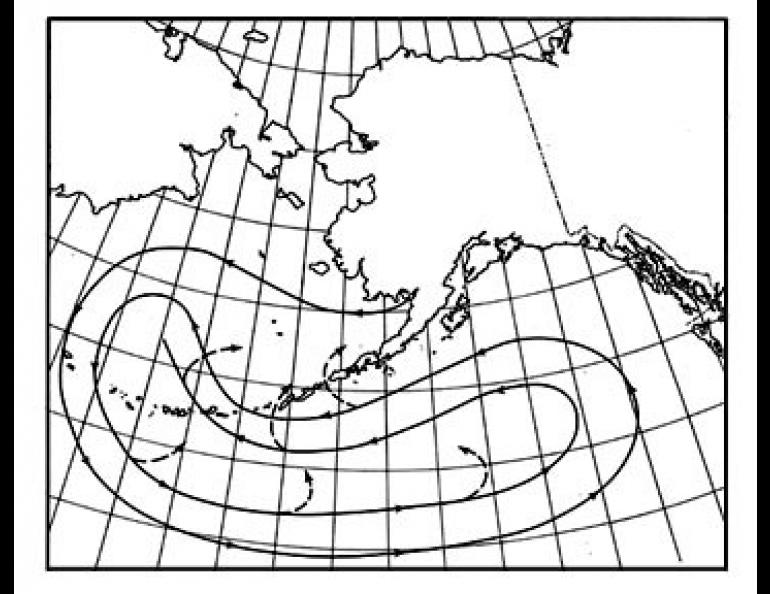
Do Salmon Navigate by the Earth's Magnetic Field?
One of the mysteries of nature is how salmon manage to navigate in the oceans and return to spawn in the very same streams from which they came. It is known that the odor or taste of the particular stream plays a role. Salmon can home-in on the smell of "their" stream if they are sufficiently close to its mouth so that the water has not been diluted to the point where it is unidentifiable.
But how can odor play a part when the fish migrate over thousands of miles in the open ocean and cross ocean currents which destroy any possible "trail" that may lead them back? At any rate, it is known that salmon do not follow meandering paths back "home" to answer the spawning instinct, but travel directly to their spawning grounds by the most direct route when sexual maturity occurs.
For example, sockeye salmon leave their freshwater origins in the streams entering Bristol Bay and make their way to the Alaska Gyre in the North Pacific and western Bering Sea. They then complete one or several circumnavigations of the Gyre before starting their spawning migrations back through the Aleutians. The important point is that regardless of surface currents or other oceanographic features, the migration pattern is abruptly interrupted at any point in the circuit where the fish may find themselves when they attain the sexual maturity which induces spawning. In other words, there are no road signs pointing out the way back to their stream from the open ocean, so the fish must have some internal "map sense" by which to navigate.
What is it that points them in the right direction?
Probably there is more than one homing mechanism that fish use to find their way. An olfactory "imprint" is made on smolts as they leave their home stream. This enables them to identify it by smell as they approach it later from the ocean. But to approach the stream mouth from the open sea, at least one other imprint must first be made in order for them to arrive in the general area. It has been shown that some fish are remarkably perceptive of the sun's azimuth and altitude, and that they are sensitive to the time of day. Under ideal conditions, this would permit a method of determining geographic north. But in a region where overcast conditions predominate (as they do in the North Pacific and Bering Sea), and because the fish move at night and in deeper water during the day, celestial clues are not consistently available.Therefore another means of correcting navigation is probably used. It is strongly suspected that the ability to sense the earth's magnetic field may provide this additional method.
It has already been demonstrated that such diverse creatures as homing pigeons, salamanders and bees can detect a magnetic field. So can salmon fry; that will change their orientation when subjected to an artificially applied magnetic field.
Extrapolating these findings to the migration process, the conjecture is that, after the salmon fry have grown to smolts and entered salt water, chemical and hormonal changes occur which imprint upon the fishes' nervous system a "memory" of its magnetic latitude and longitude at the time that it enters the ocean.
There appear to be two possible ways by which the magnetic field can influence a fish's nervous system. The first is that the ferromagnetic mineral magnetite in the creature's brain may function as a biological compass which is "set" at the time of entry into the ocean (magnetite occurs across the biologic spectrum from bacteria to dolphins). The information retained is the vertical and horizontal components of the earth's magnetic field at that point, and the declination of the horizontal component, which is the difference between magnetic and true north, presumably determined by the sun. These factors taken together provide a combination that is unique for any geographic location.
Another means by which it may be possible for a fish to sense the magnetic field is by merely moving through the water. When a long conductor, say a wire, is moved across a magnetic field, an electrical current which is dependent on the field is set up in the wire. If the fish's nervous system functions approximately as a wire under these circumstances, possibly the amount of current generated could tell the fish in which direction it was heading.
At present, this is all hypothetical, but experiments may soon begin in Alaska to test the hypothesis. Mike Cheek, a Ph.D. candidate and Professor Tsuneo Nishiyama of the University of Alaska's Institute of Marine Science hope to begin such a study in collaboration with Professor David Stone of the Geophysical Institute.
The initial efforts will be made under controlled conditions during which salmon fry will be reared and brought to the smolt stage artificially by injection. They will then be subjected to a variety of controlled lighting and magnetic field conditions; and experiments will be made along the way to determine the degree to which the fish have acquired imprinting.
A final field test of the program might be one in which fish stocks from, say, Ketchikan would be imprinted with the geomagnetic characteristics of Cold Bay at the end of the Alaska Peninsula. If the fish were to be released at Ketchikan and then captured at Cold Bay during their final migration, the hypothesis of geomagnetic imprinting as a means of open sea navigation would prove to be true.





